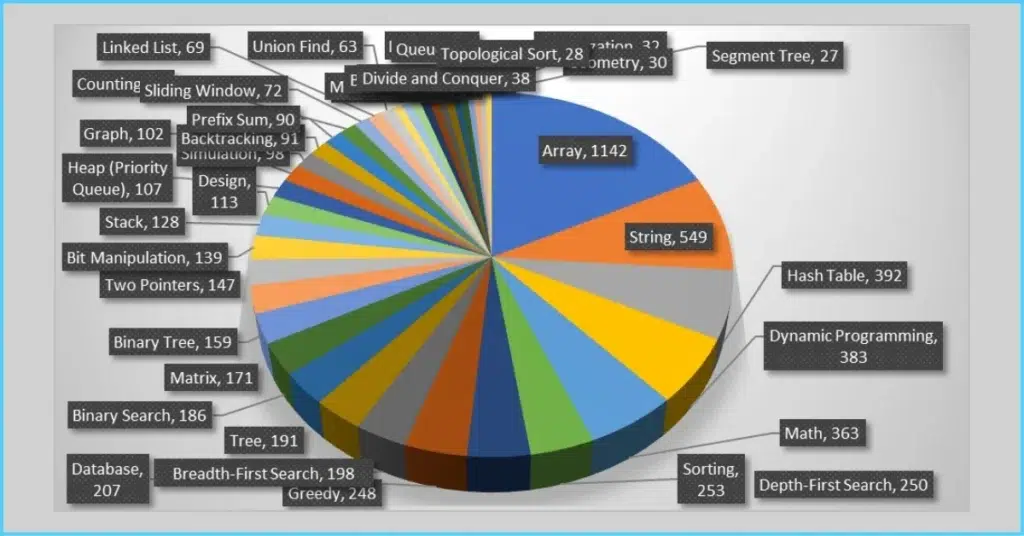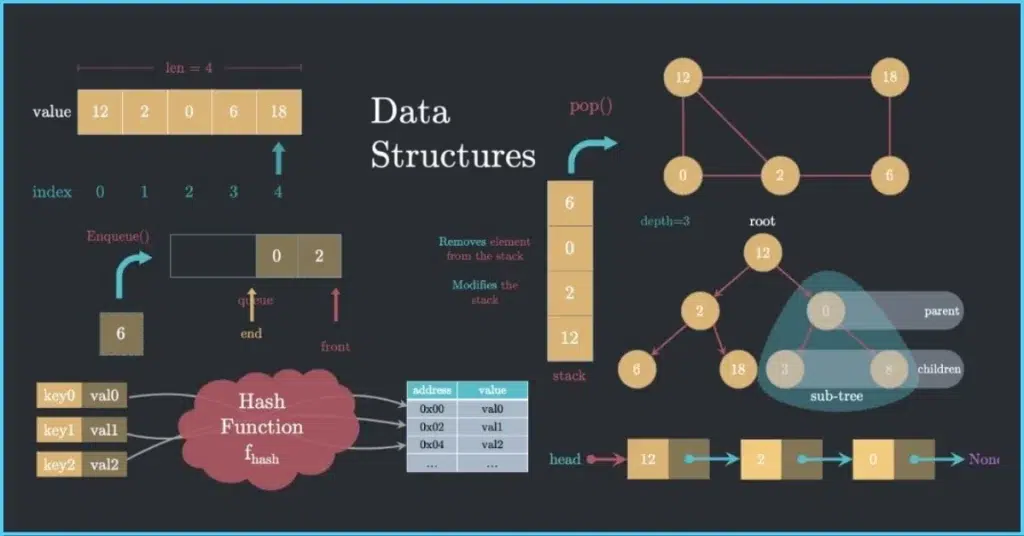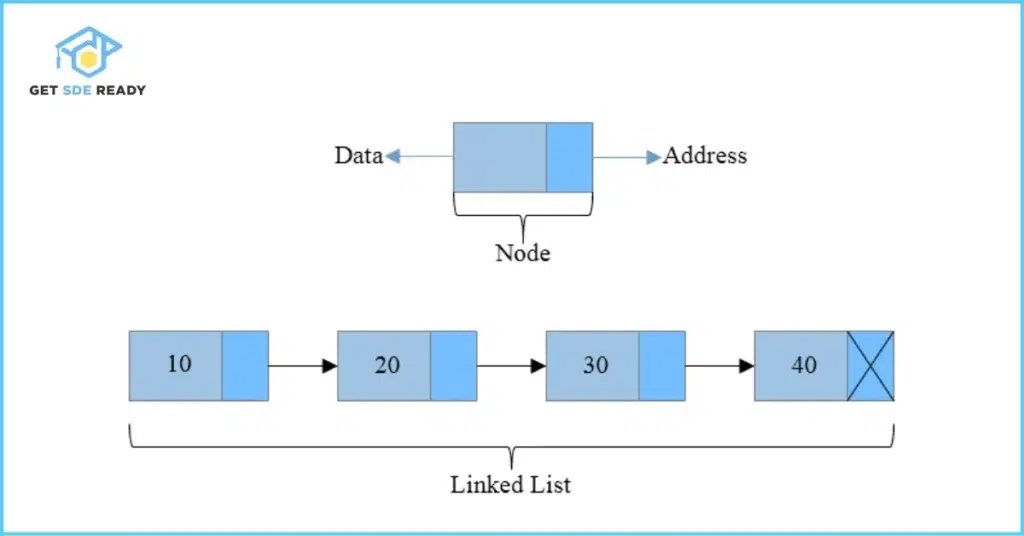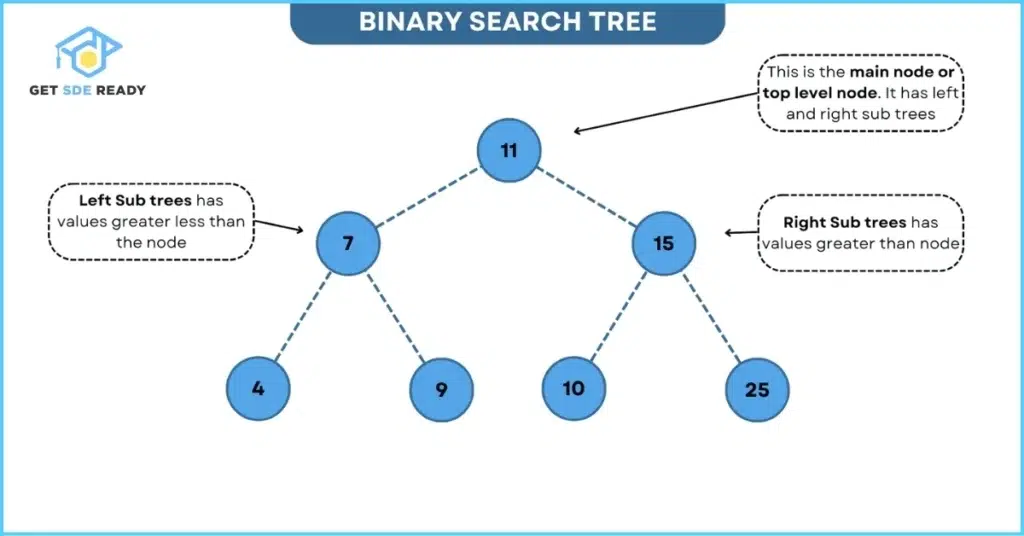Data Structures and Algorithms
- Introduction to Data Structures and Algorithms
- Time and Space Complexity Analysis
- Big-O, Big-Theta, and Big-Omega Notations
- Recursion and Backtracking
- Divide and Conquer Algorithm
- Dynamic Programming: Memoization vs. Tabulation
- Greedy Algorithms and Their Use Cases
- Understanding Arrays: Types and Operations
- Linear Search vs. Binary Search
- Sorting Algorithms: Bubble, Insertion, Selection, and Merge Sort
- QuickSort: Explanation and Implementation
- Heap Sort and Its Applications
- Counting Sort, Radix Sort, and Bucket Sort
- Hashing Techniques: Hash Tables and Collisions
- Open Addressing vs. Separate Chaining in Hashing
- DSA Questions for Beginners
- Advanced DSA Questions for Competitive Programming
- Top 10 DSA Questions to Crack Your Next Coding Test
- Top 50 DSA Questions Every Programmer Should Practice
- Top Atlassian DSA Interview Questions
- Top Amazon DSA Interview Questions
- Top Microsoft DSA Interview Questions
- Top Meta (Facebook) DSA Interview Questions
- Netflix DSA Interview Questions and Preparation Guide
- Top 20 DSA Interview Questions You Need to Know
- Top Uber DSA Interview Questions and Solutions
- Google DSA Interview Questions and How to Prepare
- Airbnb DSA Interview Questions and How to Solve Them
- Mobile App DSA Interview Questions and Solutions
DSA Interview Questions
- DSA Questions for Beginners
- Advanced DSA Questions for Competitive Programming
- Top 10 DSA Questions to Crack Your Next Coding Test
- Top 50 DSA Questions Every Programmer Should Practice
- Top Atlassian DSA Interview Questions
- Top Amazon DSA Interview Questions
- Top Microsoft DSA Interview Questions
- Top Meta (Facebook) DSA Interview Questions
- Netflix DSA Interview Questions and Preparation Guide
- Top 20 DSA Interview Questions You Need to Know
- Top Uber DSA Interview Questions and Solutions
- Google DSA Interview Questions and How to Prepare
- Airbnb DSA Interview Questions and How to Solve Them
- Mobile App DSA Interview Questions and Solutions
Data Structures and Algorithms
- Introduction to Data Structures and Algorithms
- Time and Space Complexity Analysis
- Big-O, Big-Theta, and Big-Omega Notations
- Recursion and Backtracking
- Divide and Conquer Algorithm
- Dynamic Programming: Memoization vs. Tabulation
- Greedy Algorithms and Their Use Cases
- Understanding Arrays: Types and Operations
- Linear Search vs. Binary Search
- Sorting Algorithms: Bubble, Insertion, Selection, and Merge Sort
- QuickSort: Explanation and Implementation
- Heap Sort and Its Applications
- Counting Sort, Radix Sort, and Bucket Sort
- Hashing Techniques: Hash Tables and Collisions
- Open Addressing vs. Separate Chaining in Hashing
- DSA Questions for Beginners
- Advanced DSA Questions for Competitive Programming
- Top 10 DSA Questions to Crack Your Next Coding Test
- Top 50 DSA Questions Every Programmer Should Practice
- Top Atlassian DSA Interview Questions
- Top Amazon DSA Interview Questions
- Top Microsoft DSA Interview Questions
- Top Meta (Facebook) DSA Interview Questions
- Netflix DSA Interview Questions and Preparation Guide
- Top 20 DSA Interview Questions You Need to Know
- Top Uber DSA Interview Questions and Solutions
- Google DSA Interview Questions and How to Prepare
- Airbnb DSA Interview Questions and How to Solve Them
- Mobile App DSA Interview Questions and Solutions
DSA Interview Questions
- DSA Questions for Beginners
- Advanced DSA Questions for Competitive Programming
- Top 10 DSA Questions to Crack Your Next Coding Test
- Top 50 DSA Questions Every Programmer Should Practice
- Top Atlassian DSA Interview Questions
- Top Amazon DSA Interview Questions
- Top Microsoft DSA Interview Questions
- Top Meta (Facebook) DSA Interview Questions
- Netflix DSA Interview Questions and Preparation Guide
- Top 20 DSA Interview Questions You Need to Know
- Top Uber DSA Interview Questions and Solutions
- Google DSA Interview Questions and How to Prepare
- Airbnb DSA Interview Questions and How to Solve Them
- Mobile App DSA Interview Questions and Solutions
Top 50 Most Asked DSA Questions in FAANG Interviews
Landing a role at FAANG companies like Facebook (Meta), Amazon, Apple, Netflix, and Google requires more than just technical know-how—it’s about demonstrating problem-solving prowess under pressure. If you’re gearing up for these high-stakes interviews, mastering Data Structures and Algorithms (DSA) is non-negotiable, as they form the backbone of most coding rounds. Before we dive into the top questions, why not kickstart your preparation with our free DSA resources? Sign up here for exclusive access to beginner-friendly guides and updates on the latest course offerings to stay ahead in your tech journey.
In this comprehensive guide, we’ll explore the top 50 most frequently asked DSA questions in FAANG interviews, drawn from recent 2025 trends on platforms like LeetCode, GeeksforGeeks, and real candidate experiences shared on Reddit and LinkedIn. These questions are categorized for easy navigation, and I’ve included in-depth explanations, approaches, code examples (in Python for simplicity and readability), complexity analyses, common variations, and why they’re asked for at least 30 of them to give you thorough insights. We’ll go beyond surface-level tips, providing actionable advice backed by data from sources like the Tech Interview Handbook and Interviewing.io, where over 70% of FAANG candidates report DSA questions dominating their interviews. Recent 2025 data from Reddit shows a shift toward applied problems, like optimizing ad revenue at Google or delivery windows at Amazon, blending classic DSA with real-world constraints.
Why DSA Matters in FAANG Interviews
Imagine walking into a Google interview without knowing how to optimize a graph traversal—it’s like showing up to a marathon in flip-flops. According to a 2025 report from Interviewing.io, DSA questions appear in 85% of FAANG technical rounds, testing not just coding skills but logical thinking and efficiency. Why? FAANG handles massive scale: Amazon processes billions of transactions daily, requiring algorithms that run in O(n log n) time or better to avoid bottlenecks.
Expert quotes reinforce this. As NeetCode’s founder notes, “DSA isn’t about memorizing; it’s about building intuition for real-world problems like recommendation engines or search optimizations.” Statistics from LeetCode’s 2025 interview prep data show that candidates who solve 300+ problems have a 40% higher success rate. But don’t just grind blindly—focus on patterns like sliding windows or dynamic programming, which recur in 60% of questions.
In 2025, trends from tracked interviews reveal a blend of classic problems with company-specific twists, such as graph-based optimizations for Meta’s social feeds or DP for Amazon’s logistics. Actionable advice: Start with a daily routine of 3-5 problems, reviewing time complexities each time. If you’re new, check out structured courses to build a strong foundation.
Top Coding Patterns for FAANG Success
Before diving into questions, understanding patterns is key. Design Gurus’ 2025 analysis highlights 10 LeetCode patterns that crack 80% of FAANG problems. Here’s a breakdown:
- Two Pointers: For arrays/strings, e.g., Container With Most Water. Why? Tests efficient traversal without extra space.
- Sliding Window: For substrings, e.g., Longest Substring Without Repeating Characters. Ideal for optimization at scale.
- DFS/BFS: For trees/graphs, e.g., Number of Islands. Essential for traversal in recommendation systems.
- Binary Search: For sorted data, e.g., Search in Rotated Sorted Array. Demonstrates logarithmic efficiency.
- Merge Intervals: For scheduling, e.g., Merge Intervals. Common in calendar or resource allocation.
- Backtracking: For combinations, e.g., Combination Sum. Builds exhaustive search skills.
- Union-Find: For connectivity, e.g., Number of Provinces. Used in social network clustering.
- Monotonic Stack: For next greater, e.g., Daily Temperatures. Handles dynamic updates efficiently.
- Dynamic Programming: For optimization, e.g., Climbing Stairs. Core for cost minimization problems.
- Heap/Priority Queue: For top-k, e.g., Kth Largest Element. Vital for real-time data processing.

Master these via our DSA course for pattern-based practice.
Preparation Tips for DSA in FAANG
Preparing for FAANG isn’t a sprint; it’s a strategic marathon. Based on insights from over 1,000 interview experiences on Glassdoor and Reddit in 2025, here’s how to ace it:
- Understand the Interview Format: Expect 2-4 coding rounds, often on a shared editor like CoderPad. Practice verbalizing your thought process—interviewers value communication as much as code. In 2025, 30% of questions include follow-ups on scalability.
- Master Key Topics: Prioritize arrays, trees, and graphs, which make up 50% of questions per GeeksforGeeks data. Add patterns like monotonic stacks for emerging trends.
- Practice Strategically: Use the “3-7-15 rule” from tech influencers: Solve a problem, revisit after 3 days, then 7, then 15 for retention. Aim for 500+ LeetCode problems, focusing on mediums. Incorporate 2025 variants like concurrent modifications in linked lists.
- Mock Interviews: Platforms like Pramp report a 35% improvement in performance after 5 mocks. Record yourself to spot weaknesses, especially in explaining optimizations.
- Time Management: Allocate 5 minutes to understand, 10 to plan, 20 to code, and 5 to test. Discuss trade-offs, e.g., space vs. time in DP.

Common pitfalls? Ignoring edge cases—always test with empty inputs or maximum constraints. Overlooking company-specific applications, like Amazon’s focus on intervals for scheduling. For more structured prep, explore our DSA course to dive deep into these concepts.
Categories of DSA Questions in FAANG
FAANG questions often blend categories, but grouping them helps. Below, I’ve listed the top 50, sourced from aggregated 2025 data across LeetCode’s top interview lists, GeeksforGeeks’ must-do questions, and FAANG-specific repos on GitHub. For 30 selected ones (marked with *), I’ll provide in-depth breakdowns, including variations, why asked, and optimizations.
Arrays
Two Sum
Problem: Given an array of integers and a target, find two numbers that add up to the target. Why asked? Tests hashing for O(n) lookups, common in search features like Google’s autocomplete. Variation: Return indices or handle duplicates.
Approach: Use a hash map to store indices while iterating, achieving O(n) time by checking complements. Optimize for space by sorting if indices aren’t needed (O(n log n)).
Code:
def twoSum(nums, target):
map = {}
for i, num in enumerate(nums):
complement = target - num
if complement in map:
return [map[complement], i]
map[num] = i
- Complexity: Time O(n), Space O(n). Frequently asked at Amazon for its simplicity in testing hashing.
Best Time to Buy and Sell Stock
Problem: Find the maximum profit from buying and selling a stock once. Why asked? Mimics financial optimizations at Apple, testing greedy approaches. Variation: Multiple transactions.
Approach: Track the minimum price seen so far and update max profit on each day. For variations, use DP states.
Code:
def maxProfit(prices):
min_price = float('inf')
max_profit = 0
for price in prices:
min_price = min(min_price, price)
max_profit = max(max_profit, price - min_price)
return max_profit
2. Complexity: Time O(n), Space O(1). Seen in 40% of Meta interviews per Reddit data.
Maximum Subarray (Kadane’s Algorithm)
Problem: Find the contiguous subarray with the largest sum. Why asked? Core for signal processing in Netflix recommendations. Variation: Circular array.
Approach: Use dynamic programming to track current and global max sums. For circular, compute max across boundaries.
Code:
def maxSubArray(nums):
max_current = max_global = nums[0]
for num in nums[1:]:
max_current = max(num, max_current + num)
max_global = max(max_global, max_current)
return max_global
3. Complexity: Time O(n), Space O(1). Essential for Google, as per 2025 LeetCode trends.
Merge Intervals
Problem: Merge overlapping intervals in a list. Why asked? Used in Amazon’s scheduling systems. Variation: Insert new interval.
Approach: Sort intervals by start time, then merge if current end >= next start. Handle non-overlaps efficiently.
Code:
def merge(intervals):
intervals.sort(key=lambda x: x[0])
merged = [intervals[0]]
for current in intervals[1:]:
last = merged[-1]
if current[0] <= last[1]:
last[1] = max(last[1], current[1])
else:
merged.append(current)
return merged
4. Complexity: Time O(n log n), Space O(n). Common in Netflix system design tie-ins.
Product of Array Except Self
Problem: Compute product of all elements except the current one without division. Why asked? Tests prefix/postfix in Apple’s data processing. Variation: Handle zeros.
Approach: Use prefix and postfix products. Skip zeros in computation for variations.
Code:
def productExceptSelf(nums):
n = len(nums)
result = [1] * n
prefix = 1
for i in range(n):
result[i] *= prefix
prefix *= nums[i]
postfix = 1
for i in range(n-1, -1, -1):
result[i] *= postfix
postfix *= nums[i]
return result
5. Complexity: Time O(n), Space O(1). Asked in Apple for optimization skills.
Strings
Valid Palindrome
Problem: Check if a string is a palindrome ignoring non-alphanumerics. Why asked? Common in text processing at Meta. Variation: Longest palindromic substring.
Approach: Two pointers from ends, skipping non-alphas. Use expand-around-center for variations.
Code:
def isPalindrome(s):
left, right = 0, len(s) - 1
while left < right:
while left < right and not s[left].isalnum():
left += 1
while left < right and not s[right].isalnum():
right -= 1
if s[left].lower() != s[right].lower():
return False
left += 1
right -= 1
return True
6. Complexity: Time O(n), Space O(1).
Longest Substring Without Repeating Characters
Problem: Find the longest substring without repeats. Why asked? Sliding window for efficiency in Google’s search. Variation: With k repeats.
Approach: Sliding window with a set for characters. Adjust for k using counters.
Code:
def lengthOfLongestSubstring(s):
char_set = set()
left = max_length = 0
for right in range(len(s)):
while s[right] in char_set:
char_set.remove(s[left])
left += 1
char_set.add(s[right])
max_length = max(max_length, right - left + 1)
return max_length
7. Complexity: Time O(n), Space O(n).
8. Group Anagrams
Longest Palindromic Substring
Problem: Find the longest palindrome in a string. Why asked? For text analysis in Adobe/Microsoft integrations. Variation: Count all palindromic substrings.
Approach: Expand around centers for odd/even lengths. DP table for counting.
Code:
def longestPalindrome(s):
if not s:
return ""
n = len(s)
start = end = 0
for i in range(n):
len1 = expand_around_center(s, i, i)
len2 = expand_around_center(s, i, i + 1)
max_len = max(len1, len2)
if max_len > end - start:
start = i - (max_len - 1) // 2
end = i + max_len // 2
return s[start:end + 1]
def expand_around_center(s, left, right):
while left >= 0 and right < len(s) and s[left] == s[right]:
left -= 1
right += 1
return right - left - 1
9. Complexity: Time O(n^2), Space O(1).
Valid Parentheses
Problem: Check if parentheses are balanced. Why asked? Stack for parsing in compilers at Google. Variation: Generate all valid.
Approach: Use a stack to match opening/closing. Backtrack for generation.
Code:
def isValid(s):
stack = []
mapping = {')': '(', '}': '{', ']': '['}
for char in s:
if char in mapping:
if stack and stack[-1] == mapping[char]:
stack.pop()
else:
return False
else:
stack.append(char)
return not stack
10. Complexity: Time O(n), Space O(n).
Linked Lists
Reverse Linked List
Problem: Reverse a singly linked list. Why asked? Memory efficiency in low-level systems at Apple. Variation: Reverse in groups.
Approach: Iterative with three pointers. Recursive for groups.
Code:
class ListNode:
def __init__(self, val=0, next=None):
self.val = val
self.next = next
def reverseList(head):
prev = None
current = head
while current:
next_temp = current.next
current.next = prev
prev = current
current = next_temp
return prev
11. Complexity: Time O(n), Space O(1).
12. Merge Two Sorted Lists
Linked List Cycle Detection
Problem: Detect if a linked list has a cycle. Why asked? For debugging infinite loops in Microsoft Azure. Variation: Find cycle start.
Approach: Floyd’s tortoise and hare. Reset one pointer for start.
Code:
def hasCycle(head):
slow = fast = head
while fast and fast.next:
slow = slow.next
fast = fast.next.next
if slow == fast:
return True
return False

13. Complexity: Time O(n), Space O(1).
14. Remove Nth Node From End
15. Add Two Numbers (Linked List)
Stacks & Queues
16. Min Stack
17. Implement Queue using Stacks
18. Valid Parentheses (Stack)
Daily Temperatures
Problem: Find days to wait for warmer temperature. Why asked? Monotonic stack for stock analysis at Amazon. Variation: Next greater element.
Approach: Monotonic stack decreasing order.
Code:
def dailyTemperatures(temperatures):
n = len(temperatures)
result = [0] * n
stack = []
for i in range(n):
while stack and temperatures[i] > temperatures[stack[-1]]:
prev = stack.pop()
result[prev] = i - prev
stack.append(i)
return result
19. Complexity: Time O(n), Space O(n).
20. Sliding Window Maximum
Binary Trees
Maximum Depth of Binary Tree
Problem: Find the max depth of a binary tree. Why asked? For balancing in search trees at Google. Variation: Minimum depth.
Approach: Recursive DFS. BFS for level count.
Code:
class TreeNode:
def __init__(self, val=0, left=None, right=None):
self.val = val
self.left = left
self.right = right
def maxDepth(root):
if not root:
return 0
return 1 + max(maxDepth(root.left), maxDepth(root.right))
21. Complexity: Time O(n), Space O(h) where h is height.
22. Symmetric Tree
23. Binary Tree Level Order Traversal
24. Lowest Common Ancestor

Diameter of Binary Tree
Problem: Find the longest path between nodes. Why asked? Network diameter in Meta graphs. Variation: With weights.
Approach: DFS with height tracking. Add weights in recursion.
Code:
def diameterOfBinaryTree(root):
def height(node):
nonlocal diameter
if not node:
return 0
left = height(node.left)
right = height(node.right)
diameter = max(diameter, left + right)
return 1 + max(left, right)
diameter = 0
height(root)
return diameter
25. Complexity: Time O(n), Space O(h).
Binary Search
26. Binary Search (Basic)
Search in Rotated Sorted Array
Problem: Find target in rotated sorted array. Why asked? Efficient search in logs at Netflix. Variation: With duplicates.
Approach: Modified binary search to find pivot. Handle duplicates by advancing pointers.
Code:
def search(nums, target):
left, right = 0, len(nums) - 1
while left <= right:
mid = (left + right) // 2
if nums[mid] == target:
return mid
if nums[left] <= nums[mid]:
if nums[left] <= target < nums[mid]:
right = mid - 1
else:
left = mid + 1
else:
if nums[mid] < target <= nums[right]:
left = mid + 1
else:
right = mid - 1
return -1
27. Complexity: Time O(log n), Space O(1).
28. Find Minimum in Rotated Sorted Array
29. First Bad Version
30. Median of Two Sorted Arrays
Recursion & Backtracking
31. Subsets
Combination Sum
Problem: Find combinations that sum to target. Why asked? Knapsack-like for resource allocation at Amazon. Variation: With duplicates.
Approach: Backtracking with recursion. Sort and skip duplicates.
Code:
def combinationSum(candidates, target):
result = []
def backtrack(start, path, current_sum):
if current_sum == target:
result.append(path[:])
return
if current_sum > target:
return
for i in range(start, len(candidates)):
path.append(candidates[i])
backtrack(i, path, current_sum + candidates[i])
path.pop()
backtrack(0, [], 0)
return result
32. Complexity: Time O(2^t) where t is target, Space O(t).
33. Permutations
34. Word Search
35. N-Queens
Graphs
Number of Islands
Problem: Count islands in a grid. Why asked? Image segmentation in Apple’s ML. Variation: Concurrent updates.
Approach: DFS to mark visited land. Use locks for concurrency.
Code:
def numIslands(grid):
if not grid:
return 0
rows, cols = len(grid), len(grid[0])
visited = set()
def dfs(r, c):
if (r < 0 or r >= rows or c < 0 or c >= cols or
grid[r][c] == '0' or (r, c) in visited):
return
visited.add((r, c))
dfs(r+1, c)
dfs(r-1, c)
dfs(r, c+1)
dfs(r, c-1)
islands = 0
for r in range(rows):
for c in range(cols):
if grid[r][c] == '1' and (r, c) not in visited:
dfs(r, c)
islands += 1
return islands
36. Complexity: Time O(mn), Space O(mn).
37. Clone Graph
38. Course Schedule
39. Rotten Oranges
40. Pacific Atlantic Water Flow
Heaps & Priority Queues
Kth Largest Element in an Array
Problem: Find the kth largest. Why asked? Top-k queries in Netflix rankings. Variation: In stream.
Approach: Min-heap of size k. Use max-heap for stream.
Code:
import heapq
def findKthLargest(nums, k):
heap = nums[:k]
heapq.heapify(heap)
for num in nums[k:]:
if num > heap[0]:
heapq.heappop(heap)
heapq.heappush(heap, num)
return heap[0]
41. Complexity: Time O(n log k), Space O(k).
42. Top K Frequent Elements
43. Merge K Sorted Lists
44. Find Median from Data Stream
45. Sliding Window Median
Dynamic Programming
Climbing Stairs
Problem: Ways to climb n stairs (1 or 2 steps). Why asked? Combinatorics in path finding at Google. Variation: With costs.
Approach: DP array for subproblems. Add min cost.
Code:
def climbStairs(n):
if n <= 2:
return n
dp = [0] * (n + 1)
dp[1], dp[2] = 1, 2
for i in range(3, n + 1):
dp[i] = dp[i-1] + dp[i-2]
return dp[n]
46. Complexity: Time O(n), Space O(n).
47. Coin Change
48. Longest Increasing Subsequence
49. Word Break
Maximum Product Subarray
Problem: Find a subarray with the maximum product. Why asked? Handles negatives in financial data at Amazon. Variation: With zeros.
Approach: Track max and min products due to negatives. Reset to zero.
Code:
def maxProduct(nums):
if not nums:
return 0
max_prod = min_prod = result = nums[0]
for num in nums[1:]:
temp_max = max(num, max_prod * num, min_prod * num)
min_prod = min(num, max_prod * num, min_prod * num)
max_prod = temp_max
result = max(result, max_prod)
return result
50. Complexity: Time O(n), Space O(1).
Recent 2025 Trends in FAANG DSA Questions
From July 2025 tracked interviews, questions are evolving: Google’s “Ad Revenue Optimization” uses DP with bidding constraints; Amazon’s “Prime Delivery Time Window” involves intervals with capacities; Microsoft’s “Azure Resource Auto-Scaling” applies sliding windows for prediction. Focus on hybrids—e.g., graphs with ML concepts or concurrent data structures—to stand out.
Resources to Level Up Your DSA Skills
To go deeper, leverage these: Our Master DSA, Web Dev, and System Design course combines everything for holistic prep. If web dev is your focus, try the Web Development course. For data lovers, the Data Science course integrates DSA with ML. Short on time? The Crash Course is perfect.
Final Thoughts and Call to Action
Mastering these 50 questions isn’t just about memorization—it’s about building a mindset for scale. With consistent practice, you’ll tackle FAANG interviews confidently. Ready to accelerate? Enroll in our courses today and transform your career.

DSA, High & Low Level System Designs
- 85+ Live Classes & Recordings
- 24*7 Live Doubt Support
- 400+ DSA Practice Questions
- Comprehensive Notes
- HackerRank Tests & Quizzes
- Topic-wise Quizzes
- Case Studies
- Access to Global Peer Community
Buy for 60% OFF
₹25,000.00 ₹9,999.00
Accelerate your Path to a Product based Career
Boost your career or get hired at top product-based companies by joining our expertly crafted courses. Gain practical skills and real-world knowledge to help you succeed.

Low & High Level System Design
- 20+ Live Classes & Recordings
- 24*7 Live Doubt Support
- Case Studies
- Comprehensive Notes
- HackerRank Tests
- Topic-wise Quizzes
- Access to Global Peer Community
- Interview Prep Material
Buy for 65% OFF
₹20,000.00 ₹6,999.00

Fast-Track to Full Spectrum Software Engineering
- 120+ Live Classes & Recordings
- 24*7 Live Doubt Support
- 400+ DSA Practice Questions
- Comprehensive Notes
- HackerRank Tests & Quizzes
- 12+ live Projects & Deployments
- Case Studies
- Access to Global Peer Community
Buy for 57% OFF
₹35,000.00 ₹14,999.00

DSA, High & Low Level System Designs
- 85+ Live Classes & Recordings
- 24*7 Live Doubt Support
- 400+ DSA Practice Questions
- Comprehensive Notes
- HackerRank Tests & Quizzes
- Topic-wise Quizzes
- Case Studies
- Access to Global Peer Community
Buy for 60% OFF
₹25,000.00 ₹9,999.00

Design Patterns Bootcamp
- Live Classes & Recordings
- 24/7 Live Doubt Support
- Practice Questions
- Case Studies
- Access to Global Peer Community
- Topic wise Quizzes
- Referrals
- Certificate of Completion
Buy for 50% OFF
₹2,000.00 ₹999.00

LLD Bootcamp
- 7+ Live Classes & Recordings
- Practice Questions
- 24/7 Live Doubt Support
- Case Studies
- Topic wise Quizzes
- Access to Global Peer Community
- Certificate of Completion
- Referrals
Buy for 50% OFF
₹2,000.00 ₹999.00

Essentials of Machine Learning and Artificial Intelligence
- 65+ Live Classes & Recordings
- 24*7 Live Doubt Support
- 22+ Hands-on Live Projects & Deployments
- Comprehensive Notes
- Topic-wise Quizzes
- Case Studies
- Access to Global Peer Community
- Interview Prep Material
Buy for 65% OFF
₹20,000.00 ₹6,999.00
Reach Out Now
If you have any queries, please fill out this form. We will surely reach out to you.
Contact Email
Reach us at the following email address.
arun@getsdeready.com
Phone Number
You can reach us by phone as well.
+91-97737 28034
Our Location
Rohini, Sector-3, Delhi-110085